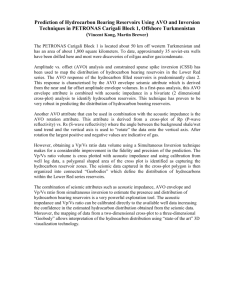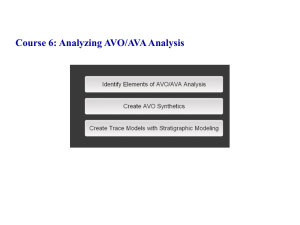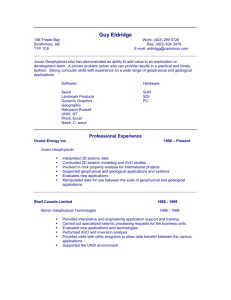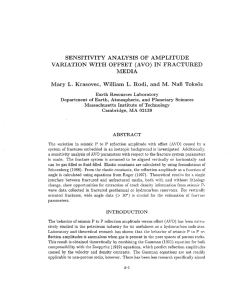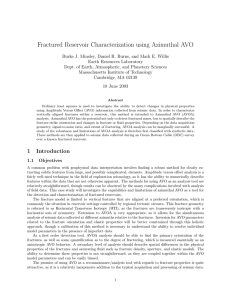Flat spots – true DHIs or false positives?
advertisement
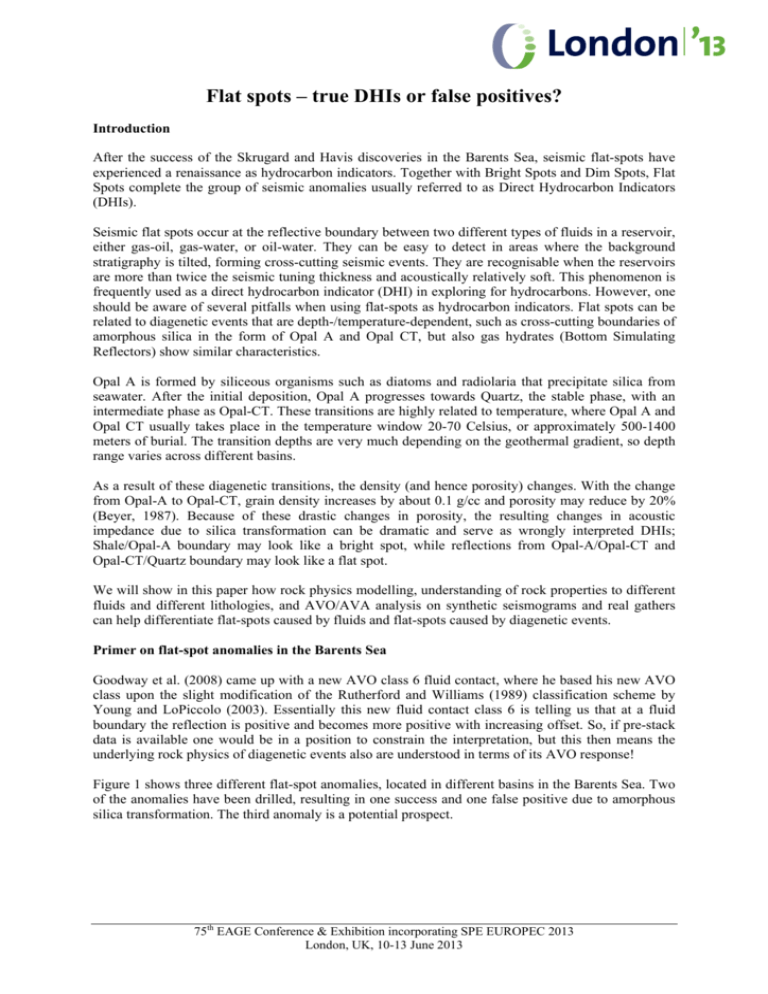
Flat spots – true DHIs or false positives? Introduction After the success of the Skrugard and Havis discoveries in the Barents Sea, seismic flat-spots have experienced a renaissance as hydrocarbon indicators. Together with Bright Spots and Dim Spots, Flat Spots complete the group of seismic anomalies usually referred to as Direct Hydrocarbon Indicators (DHIs). Seismic flat spots occur at the reflective boundary between two different types of fluids in a reservoir, either gas-oil, gas-water, or oil-water. They can be easy to detect in areas where the background stratigraphy is tilted, forming cross-cutting seismic events. They are recognisable when the reservoirs are more than twice the seismic tuning thickness and acoustically relatively soft. This phenomenon is frequently used as a direct hydrocarbon indicator (DHI) in exploring for hydrocarbons. However, one should be aware of several pitfalls when using flat-spots as hydrocarbon indicators. Flat spots can be related to diagenetic events that are depth-/temperature-dependent, such as cross-cutting boundaries of amorphous silica in the form of Opal A and Opal CT, but also gas hydrates (Bottom Simulating Reflectors) show similar characteristics. Opal A is formed by siliceous organisms such as diatoms and radiolaria that precipitate silica from seawater. After the initial deposition, Opal A progresses towards Quartz, the stable phase, with an intermediate phase as Opal-CT. These transitions are highly related to temperature, where Opal A and Opal CT usually takes place in the temperature window 20-70 Celsius, or approximately 500-1400 meters of burial. The transition depths are very much depending on the geothermal gradient, so depth range varies across different basins. As a result of these diagenetic transitions, the density (and hence porosity) changes. With the change from Opal-A to Opal-CT, grain density increases by about 0.1 g/cc and porosity may reduce by 20% (Beyer, 1987). Because of these drastic changes in porosity, the resulting changes in acoustic impedance due to silica transformation can be dramatic and serve as wrongly interpreted DHIs; Shale/Opal-A boundary may look like a bright spot, while reflections from Opal-A/Opal-CT and Opal-CT/Quartz boundary may look like a flat spot. We will show in this paper how rock physics modelling, understanding of rock properties to different fluids and different lithologies, and AVO/AVA analysis on synthetic seismograms and real gathers can help differentiate flat-spots caused by fluids and flat-spots caused by diagenetic events. Primer on flat-spot anomalies in the Barents Sea Goodway et al. (2008) came up with a new AVO class 6 fluid contact, where he based his new AVO class upon the slight modification of the Rutherford and Williams (1989) classification scheme by Young and LoPiccolo (2003). Essentially this new fluid contact class 6 is telling us that at a fluid boundary the reflection is positive and becomes more positive with increasing offset. So, if pre-stack data is available one would be in a position to constrain the interpretation, but this then means the underlying rock physics of diagenetic events also are understood in terms of its AVO response! Figure 1 shows three different flat-spot anomalies, located in different basins in the Barents Sea. Two of the anomalies have been drilled, resulting in one success and one false positive due to amorphous silica transformation. The third anomaly is a potential prospect. 75th EAGE Conference & Exhibition incorporating SPE EUROPEC 2013 London, UK, 10-13 June 2013 Figure 1: Three flat-spots in the Barents Sea. Forward modelling using elastic constants and directly from rock properties The equation for the amplitude of the reflected P-wave at a non-zero angle of incidence is fairly complicated (Zoeppritz, 1919); however, numerous approximations to the Zoeppritz reflectivity equation have been introduced over the years. They are usually called AVO approximations. Arguably, the simplest and very convenient one is by Hilterman (1990): RPP(ϴ) ≈ RPP(0) cos2(ϴ) + 2.25Δѵ sin2 (ϴ) = RPP(0) + [2.25Δѵ – RPP(0)] sin2 (ϴ) RPP(0) = ρ2Vp2 – ρ1Vp1 / ρ2Vp2 + ρ1Vp1 (3) where Δѵ = ν2 – ν1 is the difference between Poisson’s Ratio of the lower half space (ν2) and that of the upper half-space (ν1). Although approximate, equation 3 produces a reflectivity close to the exact Zoeppritz equation where the incidence angle is not large and the elastic contrast between the elastic half-spaces is not too big. Because many AVO approximations employ the form where Rpp (θ) is a function of sin2θ : Rpp (θ ) = R + Gsin2θ, (4) the two parameters commonly used to describe the character of an AVO curve are the intercept R and gradient G. For the Hilterman AVO approximation, R = RPP(0) G = 2.25Δν − RPP(0) (5) No matter whether the exact AVO equation is used or any of its approximate forms, the intercept is always; R = Rpp (0) = (Ip 2 − Ip1) /(Ip 2 + Ip1) ≈ 0.5ln(Ip 2 / Ip1). (6) Because equation 3 uses only two elastic parameters, the P-wave impedance and Poisson’s ratio, it is especially convenient for the purpose of displaying the effect of the elastic constants on the AVO curve. An example of such display is shown in Figure 2 where in an Ip versus ν plane we first select the Ip - ν point for the upper half-space and then the point for the lower half-space. From these two points and equation 3, Rpp (θ) is computed as a function of the incident angle and the intercept and gradient are determined from equation 5. Next, the resulting seismic gather is computed by 75th EAGE Conference & Exhibition incorporating SPE EUROPEC 2013 London, UK, 10-13 June 2013 convolving the Ricker wavelet with reflectivity determined at the interface at each incidence angle and displayed in a separate window (Figure 2). Figure 2: Left to right: elastic constants in the form of Ip – ν picks used in the Hilterman approximation to produce AVA, Intercept and Gradient and resulting gather for 1) opal over shale, 2) oil over brine and 3) gas over brine Another way to forward model AVO responses is directly from rock properties (Figure 3). Using this approach assumes some a-priori knowledge of applicable rock physics transforms for the interval of interest. The process that helps in establishing this rock physics transform is usually referred to in the literature as Rock Physics Diagnostics (Avseth et al., 2010). Although the correct model should be able to mimic the measured data, a perfect fit for all depth stations is not the ultimate goal. After the appropriate rock physics transform has been selected, we compute the respective Ip and ν and map it into the elastic domain. Having a proper rock physics transform enables us to calculate a range for clay content and porosity to look at uncertainty related to petrophysical interpretations. Figure 3: Left to right: 1) rock physics transforms for various lithologies and fluids,2) Ip – ν picks for three cases (explained earlier), 3) AVA for the three cases and 4) Intercept and Gradient 75th EAGE Conference & Exhibition incorporating SPE EUROPEC 2013 London, UK, 10-13 June 2013 Looking at the various picks in the cross plot, we see that all three scenarios exhibit positive amplitudes, but the important thing to notice is that the AVO signature for the two fluid/fluid scenarios (i.e. gas sand over brine sand & oil sand over brine sand cases) and the one lithology/lithology scenario (i.e. Opal over wet shale case) have opposite directions As seen in Figure 2 as well, all three gathers show positive amplitudes. But whereas the Opal over shale scenario exhibit a decrease in amplitude over increasing offset (dimming), both the gas sand over brine sand & oil sand over brine sand show an increase in amplitude over increasing offset (brightening). Conclusions By investigating how various lithologies and fluids plot in rock physics cross plot space and by forward modelling, we have theoretically come up with an intuitive way to understand flat spots in terms of AVO signatures, and hence being able to de-risk prospects showing this type of seismic response as a true DHI or false positive. Albeit theoretically possible, and intuitively correct, Mother Earth proves to be a bit more challenging as both processing, acquisition and anisotropy can misguide analysis (Pegrum et al., 2001) Acknowledgements Would to thank Maersk Oil Norway for the opportunity to show the data in Figure 1 References Avseth, A., Mukerji, T., Mavko, G. and Dvorkin, J. [2010] Rock-physics diagnostics of depositional texture, diagenetic alterations, and reservoir heterogeneity in high-porosity siliciclastic sediments and rocks — A review of selected models and suggested work flows, Geophysics, 75 (5), 75A31–75A47 Beyer, L. A. [1987] Porosity of unconsolidated sand, diatomite, and fractured shale reservoirs, South Belridge and West Cat Canyon Oil Fields, California, AAPG Studies in Geology, 25, 395 – 413 Goodway, B., Szelewski, C., Overell, S., Corbett, N. and Skrypnek, T. [2008] Calibrated AVO and LMR analysis using a new DHI flat-spot AVO class 6 fluid contact to mitigate reservoir risk at Stonehouse, offshore Nova Scotia, CSEG RECORDER, 22-32 Hilterman, F. [1990] Is AVO the seismic signature for lithology? A case history from Ship Shoal – South Addition, The Leading Edge, 9 (6), 15-22. Pegrum, R., Odegard, T., Bonde, K. and Hamann, N. E. [2001] Exploration in the Fylla area, SW Greenland, AAPG Regional Conference, St.Petersburg, Russia Rutherford, S. R. and Willimas, R. H. [1989] Amplitude-versus-offset variations in gas sands, Geophysics, 54, 680–688 Young, R. A., and LoPiccolo R. D. [2003] A Comprehensive AVO classification, The Leading Edge, October 2003, 1030-1037. Zoeppritz, K. [1919] Erdbebenwellen VIIIB. On the reflection and propagation of seismic waves. Gottinger Nachrichten, I, 66-84 75th EAGE Conference & Exhibition incorporating SPE EUROPEC 2013 London, UK, 10-13 June 2013



